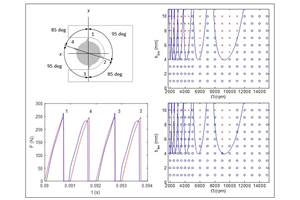Faster Off-Line Setup Helps Reduce Turret Tool Costs
At this company, a contract manufacturer specializing in sheet metal fabrication, finding ways to get more out of its turret punching operations has become a passion.
Share





At Ken-Mar Co., Inc. (Salem, New Hampshire), a contract manufacturer specializing in sheet metal fabrication, finding ways to get more out of its turret punching operations has become a passion. Using faster machinery with automated load/unload features, Ken-Mar often runs its turret punch presses round the clock without operator intervention. This, plus the trends for customer orders of smaller lot sizes and the demand for shorter lead times, have led the company to target its punch press tooling for improvements.
Ken-Mar’s challenge was to reduce its tool setup time, gain longer tool life while maintaining punching quality and do so without resorting to a total and costly replacement of the tooling it had been using. “Tooling is expensive,” says Dan Melvin, head programmer and manager of the punching department. “Tooling up a machine can cost as much as the machine it’s used in over a few years.”
The company decided on the new Ultra Tec system from Mate Precision Tooling (Anoka, Minnesota) because it had used the Ultra tooling 2 years ago and liked how it performed.
“We liked the added tool life we experienced,” Mr. Melvin says. “Our press operators saw the improvement immediately, because the tools didn’t require sharpening as often. It was easier to set up these new tools, but we were really busy and our tool inventory was full, so about all we wanted to add were replacement tools for those that wore out. All that changed when we accelerated our off-line tool setup process, which allowed us to use still-serviceable tools in our inventory along with the new tooling.
“In the past, we always bought entire tooling assemblies that consisted of punch, die, stripper and holder. Rick Maxwell, Mate’s sales representative, showed us how we could use our older but still-serviceable punches, dies and strippers in the new holders. Then as we needed them, we could add Mate Ultra Tec punches, dies and strippers. As we got into using the new tools, we really saw the advantages, because the new tools lasted longer, and we could set them up off-line with significantly less machine downtime.”
With the original tooling, when a job was complete and new tools were required for the next job, the machine was stopped and the setup process was done in the machine’s turret. This adjustment takes 1 to 5 minutes per tool, depending on the agility of the operator and the size of the tool. Additional time is required by the operator to check correct punch penetration using a height gage or calipers. When several tools require this amount of attention three or four times in an 8 hour shift, the lost machine time really adds up.
“A few minutes here and a few minutes there add up to an hour of machine downtime pretty quickly when you look at it closely,” says Mr. Melvin. “This was especially true when punches required length adjustment.
“With Mate Ultra Tec, our operators set the length in 5 seconds. Ultra’s push-button design allows for fast and easy setting of overall length and die penetration in precise increments (0.006 inch for ½-inch to 1 ½-inch station tools and 0.008 inch for the 2-inch and larger station tools) without the need for measuring tools. And the punch guide and other components are easily disassembled without the use of tools and wrenches. Reassembly is equally fast for the same reasons. So we figured we saved 30 minutes of downtime per machine per day going to Ultra.”
Just as important was the fact that Ken-Mar began buying individual tooling components only as needed—punches and strippers initially—because it was so easy to take the tooling assemblies apart to replace used components. This had a positive impact on tooling cost, because the more-efficient Mate tooling facilitated the old tooling phase-out process, so all serviceable tools were used up.
Mr. Melvin reports significant increases in tool life with Mate Ultra Tec. Many of the tools are well over a million hits and are still operating like new without requiring sharpening. But the measure of the extra tool life he hears most often is that his operators make a lot fewer trips to the tool grinder.
Related Content
The Future of High Feed Milling in Modern Manufacturing
Achieve higher metal removal rates and enhanced predictability with ISCAR’s advanced high-feed milling tools — optimized for today’s competitive global market.
Read MoreThe Impact of Cutting Teeth Spacing on Machining Stability
Many cutter designs are available, and variable teeth spacing (or variable pitch) cutters can be used to influence milling stability. Let’s discuss why teeth spacing affects stability.
Read MoreAdvanced CAMs Simplify Programming of Conical Barrel Cutters
Conical barrel cutters have grown in popularity thanks to the large stepovers that reduce the time needed for some finishing processes, but advanced CAM systems can dramatically improve their usefulness.
Read MoreInside the Process of Cutting Tool Recycling
Global Tungsten & Powders, part of the Ceratizit Group, sheds light on the processing steps that convert a shop’s used inserts into new tools and other applications.
Read MoreRead Next
A New Frontier in Surface Finish Control
What if your machine tool could measure surface roughness as it cuts? This article explores how in-process metrology is advancing from concept to reality, enabling real-time feedback, immediate detection of anomalies and new levels of control over surface quality. Discover the technologies making this possible.
Read MoreHow I Made It: Dennis Rymanowski
Dennis Rymanowski has worked at NSH USA for 60 years, with his passion for manufacturing living alongside his passion for his family’s polka band.
Read More





















